Waking up with tangled, flattened, or lifted sew-in hair extensions is frustrating-and it doesn’t have to happen. If you’ve invested in a sew-in, whether you have short natural hair or just want more volume, sleeping the right way can make the difference between a week-long style and a week-long headache. The key isn’t just avoiding bed; it’s learning how to protect your weave while you rest.
Why Sleeping Wrong Ruins Sew-Ins
Sew-in extensions are attached to braided cornrows, and the threads hold everything in place. When you toss and turn without protection, you’re pulling on those stitches. Friction from cotton pillowcases rubs against the tracks, loosening the braids over time. Sweat and oils from your scalp seep into the braids, weakening the thread. And if you sleep with your hair down, the weight of the extensions pulls on your natural hairline, leading to breakage or traction alopecia.A 2023 study from the International Journal of Trichology found that 68% of women with sew-in extensions reported visible thinning at the hairline after three months-mostly due to poor nighttime care. It’s not the extensions themselves. It’s how you treat them while you sleep.
Step 1: Braid or Twist Your Hair Before Bed
This is the single most effective habit you can adopt. Before you get into bed, gently divide your sew-in into 4-6 loose braids or twists. Start from the crown and work your way down. Don’t pull tight-this isn’t a protective style for growth, it’s a protective style for sew-in hair extensions.Loose braids keep the weight of the extensions distributed evenly. They prevent the hair from tangling against itself and stop the tracks from shifting. If you have longer extensions, braid them in sections so they don’t drag on the pillow. If your extensions are shoulder-length or shorter, two to three braids are enough.
Use soft, elastic hair ties-no metal clips or rubber bands. Silicone-covered ties work best. Avoid tight ponytails or buns. They create pressure points that can snap threads or loosen braids.
Step 2: Sleep on a Satin or Silk Pillowcase
Cotton is the enemy of sew-ins. It’s rough. It absorbs moisture. And it creates friction that tangles hair and frays the tracks. Switching to a satin or silk pillowcase cuts down on friction by up to 40%, according to hair texture experts at the American Academy of Dermatology.Satin doesn’t absorb your natural oils, so your scalp stays balanced. Silk is even smoother and cooler, which helps if you tend to overheat at night. Both materials let your hair glide instead of snag. You don’t need to buy a full silk pillowcase-just get one that’s at least 20 momme weight for durability.
Pro tip: If you can’t switch your whole pillowcase, try a satin bonnet or scarf. But a full pillowcase is better because it covers your entire head, not just the top.
Step 3: Use a Satin Bonnet or Scarf (Optional but Helpful)
If you’re someone who moves a lot in your sleep-or if you’ve had extensions come loose before-a satin bonnet adds an extra layer of protection. Put it on after you’ve braided your hair. Make sure it’s not too tight around your edges. You want it to gently hold everything in place, not squeeze your scalp.Some people prefer a wrap-style scarf. It’s easier to adjust if you wake up feeling uncomfortable. Just make sure it’s made of the same material as your pillowcase: satin or silk. Avoid cotton wraps-they defeat the purpose.
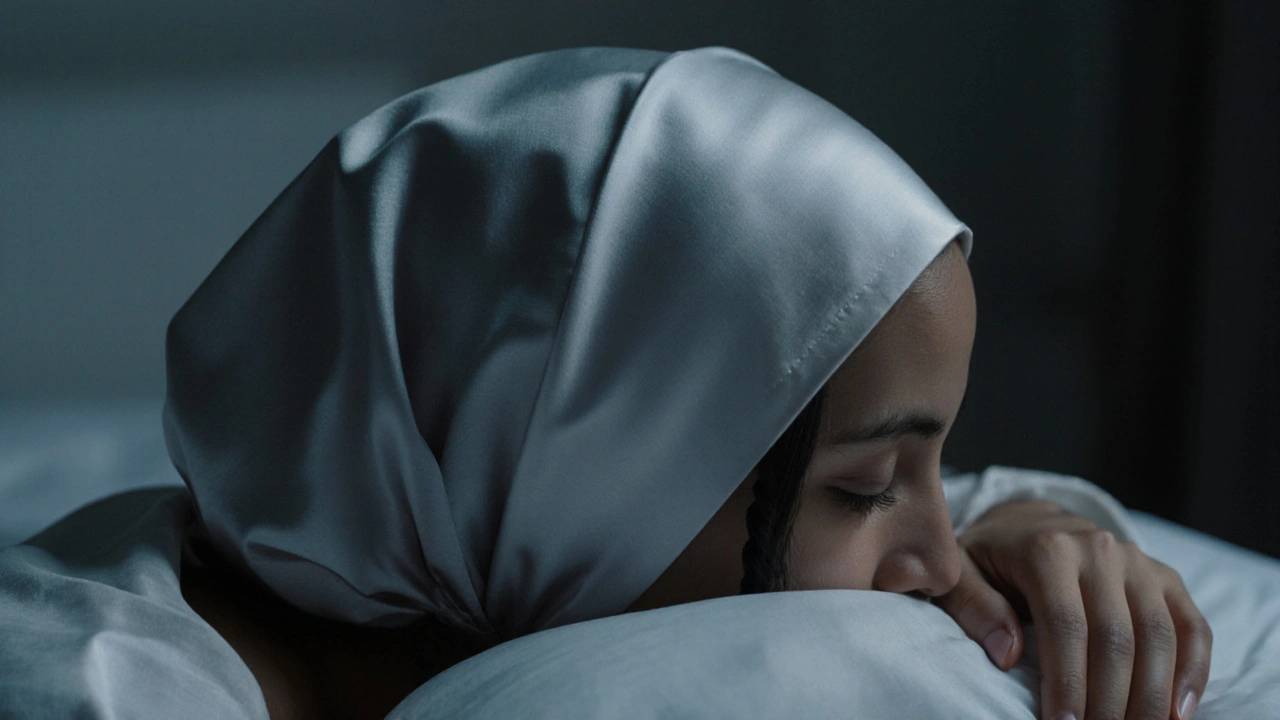
Step 4: Avoid Sleeping with Wet Hair
Wet hair is fragile. Wet sew-in extensions are even more fragile. When hair is damp, the cuticle is raised, making it prone to breakage. The moisture trapped under the braids creates a breeding ground for mildew and bacteria, which can lead to scalp irritation or odor.If you washed your hair before bed, dry it completely. Use a microfiber towel to gently squeeze out water. Then air-dry or use a diffuser on low heat. Never sleep with damp extensions. Even if they feel dry on top, the roots under the braids might still be wet.
Step 5: Keep Your Scalp Clean and Moisturized
A healthy scalp means longer-lasting extensions. Sweat, product buildup, and dead skin cells can clog your braids and loosen the thread over time. Wash your scalp every 7-10 days with a diluted shampoo. Use a spray bottle to apply it directly to your scalp-don’t soak the extensions.After washing, apply a lightweight scalp oil or serum. Jojoba oil or tea tree oil mixed with water works well. It keeps your scalp hydrated without weighing down the extensions. Avoid heavy creams or butters-they’ll clog your braids and make your hair greasy.
What Not to Do
- Don’t sleep with your hair in a high ponytail or bun. It pulls on the tracks and stresses your edges.
- Don’t use regular cotton sheets or pillowcases. They’re too abrasive.
- Don’t go to bed with styling products still on your hair. Product buildup attracts dirt and weakens the braids.
- Don’t sleep with heat tools still in your hair. Even if they’re off, residual heat can damage the extension fibers.
- Don’t ignore itching. If your scalp is itchy, it’s a sign of buildup or infection. Don’t scratch with your nails-use a scalp massager or diluted apple cider vinegar rinse.
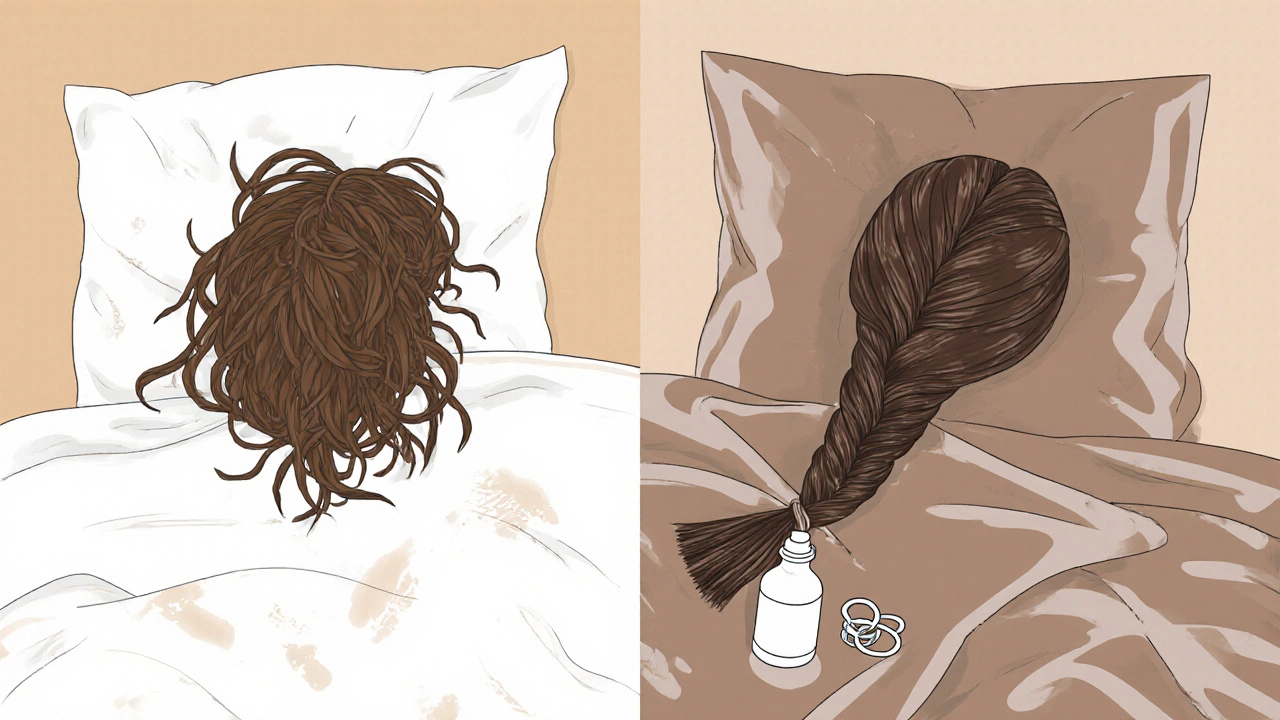
How Often Should You Re-Tighten Your Sew-In?
Most sew-ins last 6-8 weeks, but if you’re sleeping properly, you might stretch that to 10 weeks. Still, your braids will loosen over time. Signs you need a touch-up: visible scalp showing between tracks, hair feeling loose when you braid, or discomfort when you move your head.Go back to your stylist every 3-4 weeks for a re-tightening. It’s not expensive-usually $30-$60-and it saves you from having to redo the whole install. Skipping this step is the #1 reason people end up with damaged hairlines or premature removal.
What If You Wake Up with Tangles?
Even with the best routine, tangles happen. Don’t panic. Don’t yank. Use a wide-tooth comb or a detangling brush like the Tangle Teezer. Start from the ends and work your way up. Spray a leave-in conditioner or diluted apple cider vinegar solution to loosen knots.If a section is matted, cut it out carefully with small scissors. It’s better to lose a few inches than to pull out your whole weave. Never use a fine-tooth comb or brush on wet extensions-it will snap the fibers.
Best Products for Sew-In Sleep Care
- Satin pillowcase: Slip Silk Pillowcase (22 momme)
- Satin bonnet: Mielle Organics Satin Bonnet
- Scalp oil: Jamaican Black Castor Oil (mixed with water)
- Detangler: Kinky-Curly Knot Today
- Hair ties: Goody Ouchless Silicone Elastics
These aren’t brand endorsements-they’re tools that professionals use. You don’t need to spend a fortune. Look for 100% satin or mulberry silk, and avoid anything labeled ‘polyester satin’-it’s just shiny plastic.
Final Tip: Give Your Hair a Break
Even if your sew-in looks perfect, don’t wear it nonstop. After 8-10 weeks, take it out. Let your scalp breathe for at least two weeks. Wash, condition, and moisturize your natural hair. This isn’t optional-it’s essential for long-term hair health.Short hair doesn’t mean you can’t wear extensions. But it does mean you have to be more careful. Your natural hair is the foundation. Protect it while you enjoy the length.
Can I sleep with sew-in extensions in a ponytail?
No. Sleeping with your sew-in in a ponytail puts constant tension on the braids and your natural hairline. This can cause breakage, thinning, or even permanent hair loss over time. Always loosen your hair into braids or twists before bed.
How often should I wash my sew-in extensions?
Wash your scalp every 7-10 days using a diluted shampoo applied directly to your scalp with a spray bottle. Avoid soaking the extensions. Rinse thoroughly and follow with a light conditioner only on the ends. Overwashing can loosen the tracks and dry out your natural hair.
Is silk better than satin for sew-in extensions?
Silk is slightly smoother and cooler, making it ideal for hot sleepers or sensitive scalps. Satin is more affordable and still highly effective at reducing friction. Both work well as long as they’re made from real satin or mulberry silk. Avoid polyester blends-they don’t offer the same benefits.
Can I use a hair dryer on my sew-in before bed?
Yes-but only on low heat and with a diffuser. High heat can damage both your natural hair and the extensions. Always make sure your hair is completely dry before sleeping. Moisture trapped under braids leads to odor, mildew, and weakened threads.
Why do my sew-in extensions slip at night?
Slippage usually happens because the braids loosened over time, or because you’re sleeping on cotton, which creates friction. Sweat and product buildup also weaken the thread. To fix it, braid your hair before bed, use a satin pillowcase, and schedule a re-tightening every 3-4 weeks.

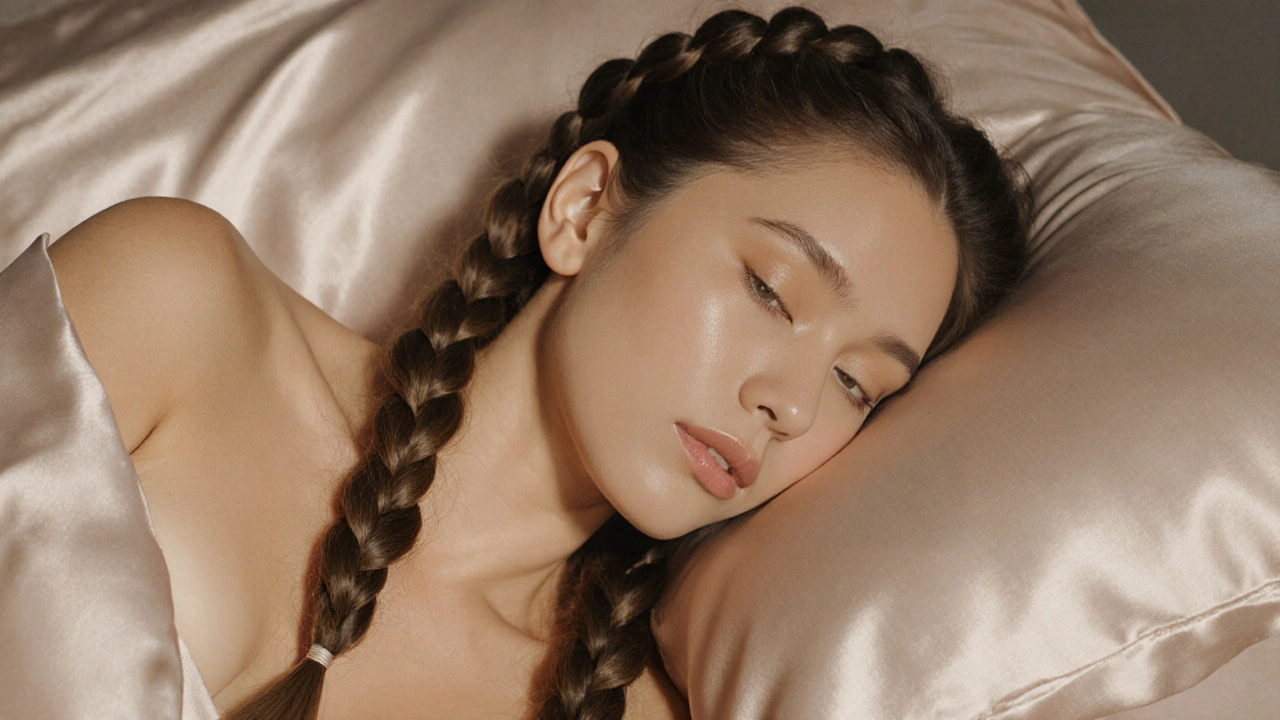
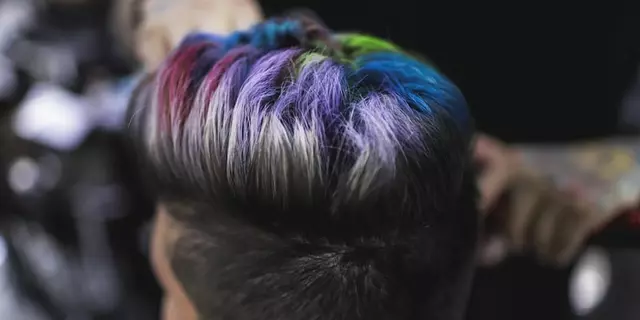
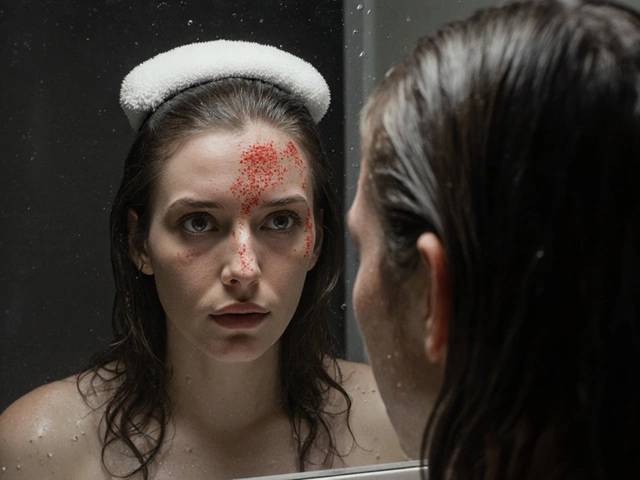

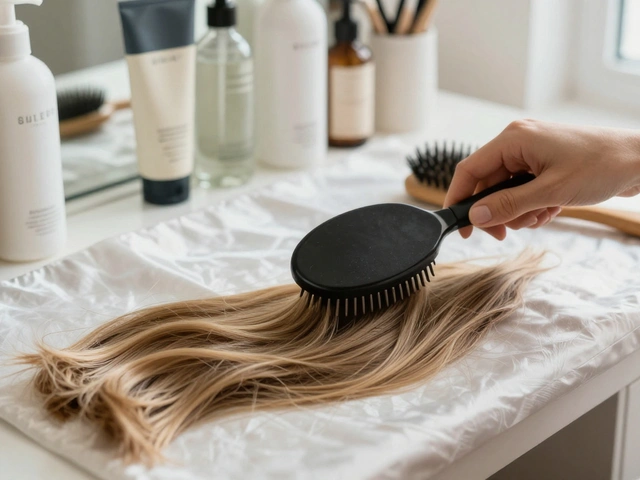

chioma okwara
October 27, 2025 AT 22:48ok so let me get this straight-you’re telling me i cant sleep like a normal human being with extensions? like i dont need to be a queen on a silk pillow like some kinda 18th century french noble? also why is everyone acting like satin is magic? my cousin in lagos sleeps on cotton and her weave lasts 3 months no problem. also ‘mulberry silk’? that’s just fancy marketing. i use a cheap polyester scarf and i’m fine. stop gaslighting us into buying expensive linens.
John Fox
October 29, 2025 AT 08:25braids before bed works. satin pillowcase works. dont sleep wet. thats it. no need for all this extra stuff. i just do the three things and im good. also stop calling it ‘sew-in hair extensions’ like its a medical device. its hair. you put it in your head. sleep on it or dont. its not rocket science.
Tasha Hernandez
October 30, 2025 AT 01:42oh my god. i just woke up from a nightmare where i spent $200 on a ‘22 momme slip silk pillowcase’ only to find out my extensions were already falling out because i forgot to ‘dilute my shampoo’ and ‘use a scalp massager’ and ‘avoid heavy creams’ and ‘not scratch with my nails’ and ‘pray to the hair gods’ before bed. who the hell are these people? are we all just supposed to become hair priests now? i just want to sleep without feeling guilty. why does my scalp need a spa day every 7 days? why am i being punished for being human? someone please tell me i can just wear a beanie and call it a night.
Anuj Kumar
October 30, 2025 AT 14:47you think this is about hair? no. this is about control. the beauty industry made up ‘sew-in maintenance’ to sell you pillows and oils and bonnets. they know you’ll panic when your hair looks messy. they want you scared. the real reason extensions slip? your braids were done bad. not your pillow. not your oil. your stylist is lazy. they charge you $300 and then tell you to buy $80 worth of ‘satin’ to cover it up. wake up.
Christina Morgan
November 1, 2025 AT 13:44Y’all need to chill. This guide is actually really solid. I’ve been wearing sew-ins for 5 years and I swear by the satin pillowcase + loose braids combo. I used to wake up with knots so bad I had to cut sections out. Now? I wake up and my hair looks like I just walked out of the salon. The scalp oil tip? Game changer. I use jojoba oil mixed with a little water every other night and my edges haven’t thinned in over a year. And yes, cotton is the enemy-I tried a cotton pillowcase once and it felt like sandpaper on my scalp. Don’t overcomplicate it. Just do the basics. Your hair will thank you.
Kathy Yip
November 3, 2025 AT 08:35i wonder if this is really about hair health or if it’s about performing care. like, are we protecting our hair… or are we performing the idea of protecting our hair? i’ve slept on cotton, i’ve slept with wet hair, i’ve worn buns at night… and my hair is fine. maybe the real issue is that we’ve been taught to fear our own natural texture. maybe the extensions are fine, and we’re the ones who’ve been trained to panic. also i think i misspelled ‘satin’ in my notes. again.
Bridget Kutsche
November 3, 2025 AT 09:06Just wanted to say thank you for this. I’m new to sew-ins and was terrified I’d ruin my hair. I tried the braids + satin pillowcase last night and honestly? I slept like a baby. No tangles, no itching, no panic. I didn’t even know a satin bonnet existed until now. I bought the Mielle one and it’s so comfy. Also, the part about not sleeping with wet hair? I used to do that all the time because I was tired. Now I just air dry before bed. Small changes, big results. You don’t need to spend a fortune-just be consistent. And yes, cotton is the devil. I threw mine out.
Jack Gifford
November 5, 2025 AT 07:04Okay but real talk-why is everyone acting like this is a new discovery? My mom had sew-ins in the 90s and she did exactly this: braids, silk scarf, no cotton. We didn’t have ‘22 momme’ or ‘mulberry silk’ back then-we had thrifted silk scarves and a $3 pillowcase from Kmart. The advice hasn’t changed. What changed is the marketing. You don’t need a brand name. You need a clean scalp, loose braids, and zero cotton. Everything else is just noise. Also, if you’re sleeping with heat tools in your hair… you need help.